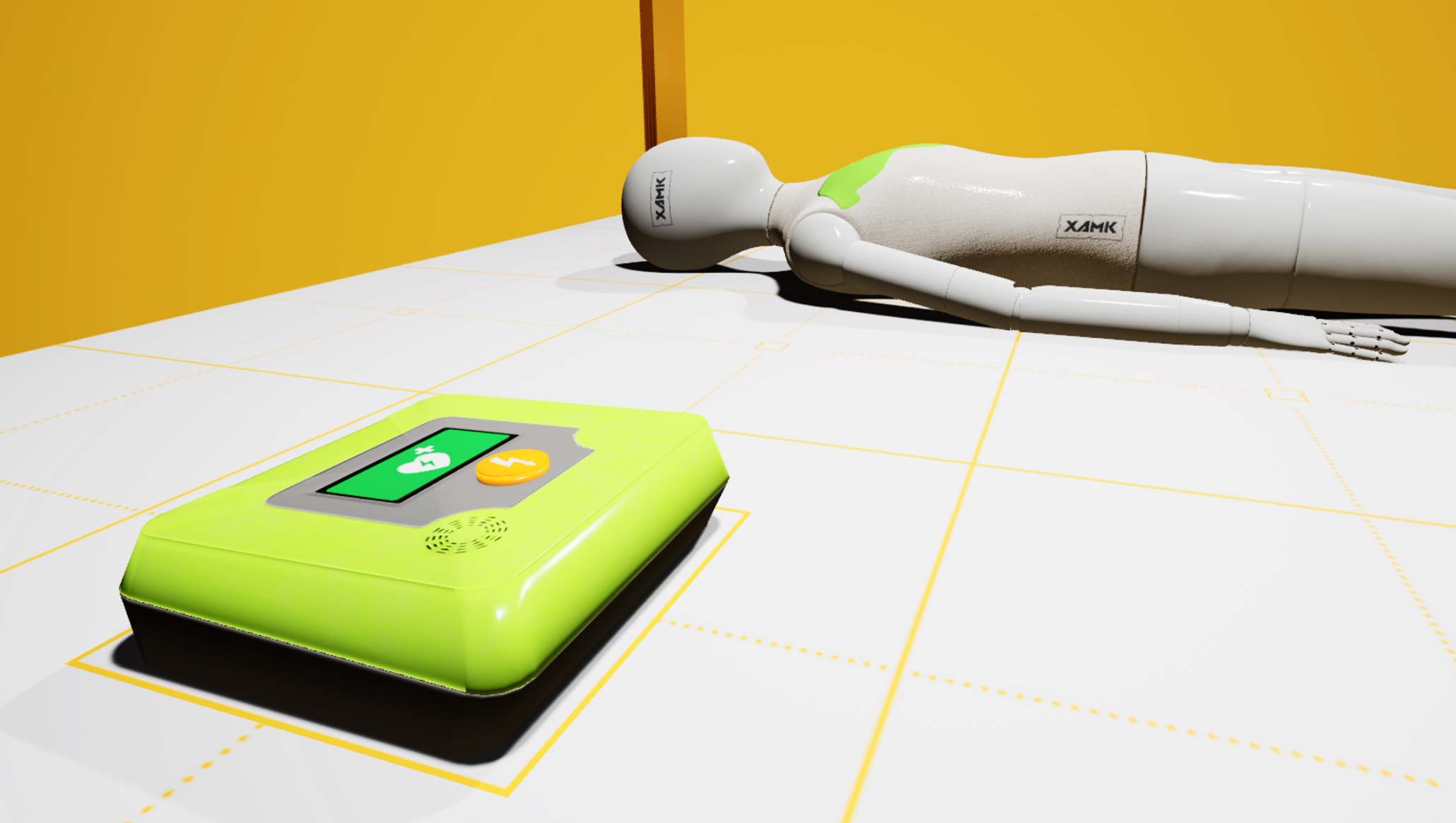Case Xamk
Learning CPR in virtual reality
HiQ developed a virtual reality (VR) game for Xamk that teaches life-saving skills and lowers the threshold for using a defibrillator.

South-Eastern Finland University of Applied Sciences (Xamk) is engaged in strong research, development, and innovation (RDI) activities, aiming to produce knowledge and solutions for businesses and working life. Xamk’s vision is to revitalize the vitality of Southeast Finland by 2030.
One of the core principles of RDI at Xamk is human-centeredness, aiming to enhance user experiences for businesses and communities and improve people’s well-being through digital services.
I would recommend HiQ as a partner any day. HiQ’s professionals are skilled, and you can talk openly with them.
Inka Vanhanen, Service Management Specialist, Xamk
Goal: A VR micro-course for a broad audience
Xamk seeks to provide lifelong learning opportunities through fast and convenient methods for acquiring new skills. In the fall of 2023, Xamk wanted to create a product utilizing virtual reality. The goal was to develop a pedagogically sound product for a wide audience that could be used with VR headsets.
After a procurement process, HiQ* was selected as the partner that best understood the pedagogical core of the product. As the project progressed, the need became clearer, and the idea emerged for a program where life-saving skills are practiced using VR headsets.
A defibrillator is a device designed to restore normal heart rhythm during cardiac arrest. It is intended for use by anyone and includes a built-in feedback system to guide effective CPR. Although no special training is required, using the device can be intimidating for those without experience.
“HiQ understood that a clear training program was needed to make it easier for people to use a defibrillator in critical situations. They identified a broad market potential and audience since CPR is a valuable skill for everyone, regardless of profession or educational background,” explains Inka Vanhanen, Xamk’s Service Management Specialist.
Solution: A VR defibrillator for CPR training
The project got off to a fast start. After smooth contract negotiations, the schedule was set, and in January 2024, HiQ’s development team traveled to Mikkeli to collect equipment and familiarize themselves with the space where a 5G cabin for VR headset use had been built.
Early in the planning phase, HiQ visited Xamk’s Kotka facilities to test defibrillators. The team gained insights from teachers about the challenges users face when using the devices. One of the key takeaways was understanding the irrational fear many people have of using defibrillators.
“Our original vision became clearer at this stage, and HiQ was able to explain why the design needed to be implemented differently than we initially imagined. It was impressive how they used their training to explain what is required to create a good product,” says Vanhanen.
The training takes place in the 5G cabin, where users wear VR headsets. The idea of the product is to gamify the learning experience just enough to keep the user motivated. In the program, users perform CPR on an androgynous character instead of a realistic human, so as not to create too much stress, which could negatively impact the learning experience.
The training begins with the user finding an unresponsive figure on the ground, checking its condition, and taking action by locating a defibrillator on the wall. The user’s task is to grab the defibrillator and prepare it for use. By following the instructions, the player performs CPR, and the training concludes when the procedure is successfully completed.
“When the training begins, actions must be performed in a specific order to ensure success. Together with HiQ, we decided to exclude competitive elements, flashing lights, and chaotic sounds that could increase stress. We wanted to create the simplest possible product, focusing on learning how to use a defibrillator in a clinical environment,” Vanhanen explains.

Results: A functional product delivered on time and within budget
Xamk deems the project as successful, as it resulted in a product that aligns with the university’s brand and purpose. The roughly four-month project stayed on schedule and within budget.
“I would recommend HiQ as a partner any day. HiQ’s professionals are skilled, and you can talk openly with them. Communication with them has been incredibly easy, clear, and efficient. Some meetings were even canceled because they weren’t needed,” Vanhanen says.
Vanhanen especially praises HiQ’s ability to quickly acquire new life-saving skills and apply them to the creation of a pedagogical product. HiQ was able to guide the product’s design so that Xamk received exactly the solution it needed, with all unnecessary elements removed. HiQ successfully identified the project’s main challenge: people’s hesitation to use a defibrillator.
The product focused on solving this challenge without deviating from its core purpose. Virtual reality training isn’t an end in itself, but a tool to serve its intended goal.
“We received a product that works just as we wanted. Working with HiQ and providing feedback was very natural, and we made small adjustments after the first concept images. Every phase of the project, from contract negotiations to design, coding, and testing, proceeded smoothly, and we are very pleased with the result.”
Collaboration in a nutshell
- A VR program for learning CPR skills
- Efficient work and communication – no unnecessary meetings
- A 4-month project delivered on time and within budget
- A product that teaches a vital life skill and lowers the threshold for using a defibrillator
*The project was executed with Great Apes, which is part of HiQ.